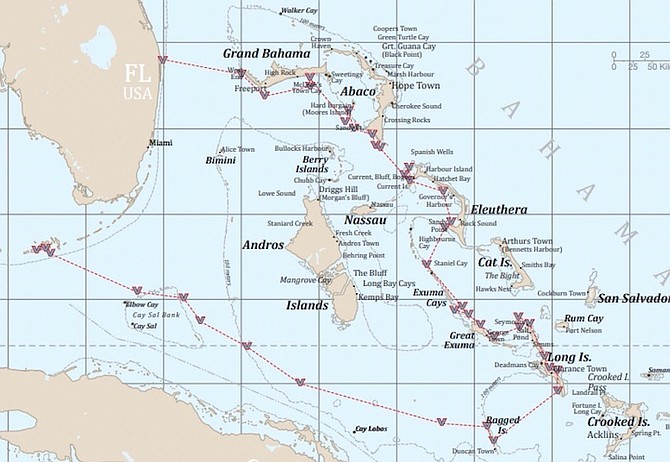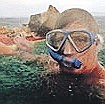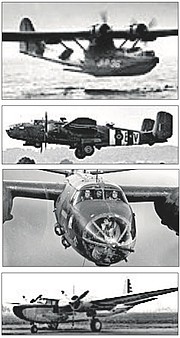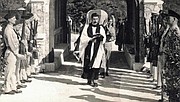By Eric Wiberg
TRIBUNE readers may recall fifteen articles about Mailboats of the Bahamas in 2016. This new series about World War Two aircraft discoveries in our archipelago is similar, except the history is less static and more tactile.
Having seen my first historic aircraft on a reef near Balmoral Island in 1985, I made no progress until 2021, when I finally relocated it during a return home. Then, suddenly, the Royal Air Force and United States military aircraft started leaping off the pages of the history books I wrote.
Thanks to the immense generosity of family, friends, and fellow enthusiasts, I was given access to seven boats with which teams of volunteers and I discovered ten historic aircraft spread between Moore’s Island, Abaco, and Ragged Island.
Over a decade of research utilising source materials and field study confirms that during World War II and soon after (1939-1945), at least 150 allied aircraft had accidents on airfields, in the oceans and on the islands of The Bahamas.
Of these, roughly 100 were salvaged and 80 were not found or recovered. The aircraft were primarily attached to the Royal Air Force (RAF) bases on New Providence: Windsor for RAF Transport Command and Oakes Field for the Operational Training Unit, a significant portion were USAAF (United States Army Air Force a precursor to the US Air Force), which had civilian personnel, and others were US Navy aviators on amphibious craft and fighters from Florida or attached to the Naval Operating Base (NOB) and Naval Air Station (NAS) in Great Exuma.
The general lack of study or knowledge of this trove of historical material is attributable to the passage of time, censorship, destruction of reports, and the death of witnesses. Online satellite imagery, drones, and diving equipment makes verifying sites more possible than ever, though Scuba and drones were not used in these cases. The potential to reconnect the Bahamian public with wartime artifacts and families of the nearly 500 servicemen who were in accidents or killed in action from Argentina, Australia, New Zealand, the UK, Canada, the US, the Czech Republic, Norway and beyond, is significant.
This is the story of the pilots, the living and those who perished, the persons who banded together to find them, and both the rapture of success finding lost men for their families as well as wrenching setbacks by weather, time and access. Behind every item found and returned using just snorkels and hiking boots lay innumerable hours of research in archives in the US, Bahamas, Canada, and UK. Then painful days alone under the sun, waist or chest deep in mangroves, and finally narrowing down hundreds of leads to call a single living relative to tell them we had found the uncle they barely knew but whose loss often left immense holes in families.
These articles cover an overview of bases and air forces involved to coverage of New Providence, which saw some 80 accidents, then all three B-26 bombers, in Cable Beach, Acklins, and Lyford Cay, a bomber destined for the USSR at Castle Island, a fighter in the village of Hard Bargain, Moore’s Island, Abaco, to an extraordinary find in Exuma of a 1930 Wright Brothers’ engine. Then we cover two B-25 bombers at Tarpum Bay and Bannerman Town, Eleuthera, followed by a Catalina flying boat just a few feet off Ragged Island, and finally the story of other US Navy amphibians, and a wrap up of wrecks at Bimini, Berry Islands, Andros, Mayaguana, Inagua, Exumas, San Salvador, and Grand Bahama.
This all began when I published the original ORBs or Operational Record Books from two primary RAF bases in Nassau, as well as from US Navy bases in Exuma and beyond. I verified 150 air accidents confirmed from 1942 to 1946 with one outlier civilian craft from 1930. Sadly 482 men died in aircraft, a Bahamian family of three were killed in Delaport by an abandoned aircraft, and 239 survived, and New Providence saw 31 non-combat deaths, by propellers, suicides, sailing, auto accidents.
With thanks to The Tribune, we will discover not just what happened and how the battle grounds were found again, but who participated, was wounded, died, rescued, mourned and buried the dead. This isn’t just steel on steel or steel on coral; it is the story of human flesh, fear, dread, motives, ambition, success, survival, and often horrific lonely deaths.
In the winter of 2021, I manically swam every day at Cable Beach Manor and found the first World War II plane, a B-26 Marauder, inspired by the fallen pilot’s niece, Joanne Green in Canada. This success inspired me to find more, so I set out to find all B-26 Marauders lost in The Bahamas; I accomplished that in less than a year and set out for a month on an old shipmate and war veteran’s 59-foot sailing yacht with a diver, mechanic, and technology expert. In three weeks, we found three aircraft and solved the locations of three others, all while sailing from West End to Ragged Island and Cay Sal Bank.
Dozens of World War sites, docks, facilities, buildings, hospitals, hotels, including graves are visible today. By 1946 the air bases and all the ancillary supports, from nurses to censors, lawyers, technicians, a rugby team newspaper, choir, hospital, engineers, undertakers, accountants, lorry drivers, base perimeter security, road builders, rescue boat operators, and much more were being wound down and repatriated. The military left the bones of many aircraft in The Bahamas burnt out or buried beneath the waves or under mangroves. They also left airfields to better enable the post-war tourism boom as well as re-discovery of their comrades.
While almost all evidence of the 113 German and Italian submarine patrols and attacks in 130 merchant ships in the greater Bahamas zone occurred in prohibitively deep water, the salient and extraordinary aspect of the research covered in these articles is how relatively easy it proved to be for well-informed and small teams of volunteers to work with those on the ground to rediscover the wreckage of so many planes so quickly.
These articles describe how volunteers rediscovered important aviation history right beneath our eyes and our feet.
• Eric Wiberg’s column will run every two weeks in The Tribune.









Comments
Use the comment form below to begin a discussion about this content.
Sign in to comment
Or login with:
OpenID